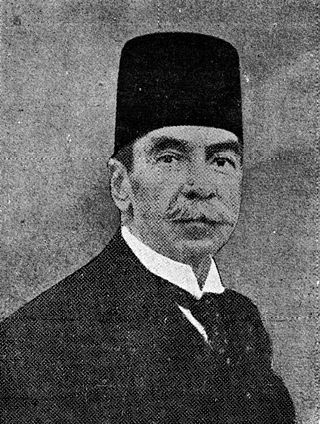Related Research Articles
Arabic literature is the writing, both as prose and poetry, produced by writers in the Arabic language. The Arabic word used for literature is Adab, which comes from a meaning of etiquette, and which implies politeness, culture and enrichment.
Denys Johnson-Davies was an eminent Arabic-to-English literary translator who translated, inter alia, several works by Nobel Prize-winning Egyptian author Naguib Mahfouz, Sudanese author Tayeb Salih, Palestinian poet Mahmud Darwish and Syrian author Zakaria Tamer.
Arabic poetry is one of the earliest forms of Arabic literature. Pre-Islamic Arabic poetry contains the bulk of the oldest poetic material in Arabic, but Old Arabic inscriptions reveal the art of poetry existed in Arabic writing in material as early as the 1st century BCE, with oral poetry likely being much older still.

Yusuf Idris, also Yusif Idris was an Egyptian writer of plays, short stories, and novels.
Zakaria Tamer, also spelled Zakariya Tamir, is a Syrian short story writer. He is one of the most widely read and translated short story writers of modern Syrian literature, as well as one of the foremost authors of children’s stories in Arabic. He also worked as a freelance journalist, writing satirical columns in Arabic newspapers.
The Nahda, also referred to as the Arab Awakening or Enlightenment, was a cultural movement that flourished in Arab-populated regions of the Ottoman Empire, notably in Egypt, Lebanon, Syria, and Tunisia, during the second half of the 19th century and the early 20th century.

Zakariya is a masculine given name, the Arabic form of Zechariah which is of Hebrew origin, meaning "God/YHWH has remembered".

Egyptian literature traces its beginnings to ancient Egypt and is some of the earliest known literature. Ancient Egyptians were the first to develop written literature, as inscriptions or in collections of papyrus, precursors to the modern book.
Yahya Haqqi was an Egyptian writer and novelist. Born to a middle-class family in Cairo, he was a lawyer by profession who graduated from the Cairo School of Law in 1925. Like many other Egyptian writers, such as Naguib Mahfouz and Yusuf Idris, he spent most of his life as a civil servant, supplementing his literary income; he eventually rose to become adviser to the National Library of Egypt.
Syrian literature is modern fiction written or orally performed in Arabic by writers from Syria since the independence of the Syrian Arab Republic in 1946. It is part of the historically and geographically wider Arabic literature. Literary works by Syrian authors in the historical region of Syria since the Umayyad era are considered general Arabic literature. In its historical development since the beginnings of compilations of the Quran in the 7th century and later written records, the Arabic language has been considered a geographically comprehensive, standardized written language due to the religious or literary works written in classical Arabic. This sometimes differs considerably from the individual regionally spoken variants, such as Syrian, Egyptian or Moroccan spoken forms of Arabic.

Mahmoud Saeed is an Iraqi-born American novelist.
Catherine Cobham is a scholar and translator of Arabic literature.
Maia Tabet is an Arabic-English literary translator with a background in editing and journalism. Born in Beirut, Lebanon, in 1956, she was raised in Lebanon, India, and England. She studied philosophy and political science at the American University in Beirut and lives between the United States and Cyprus.

Ahmed Tawfik Taymour Pasha (1871–1930) was an Egyptian writer and historian. Taymour Pasha was born on 6 November 1871 in Cairo to a family of the Egyptian elite, his father Isma'il Taymur being of Kurdish origin and his mother of Turkish descent.
Ghalib Halasa was a Jordanian novelist, short story writer, literary critic, translator, and political activist. He was a prominent literary figure in the Arabic-speaking world during the 20th century. Some of Halasa's most influential novels include al-Dhahik (Laughter), al-Su’al, and Sultana.
The instance that marked the shift in the whole of Arabic literature towards modern Arabic literature can be attributed to the Arab World-West contact during the 19th and early 20th century. This contact resulted in the gradual replacement of Classical Arabic forms with Western ones. Genres like plays, novels, and short stories were coming to the fore. Although the exact date in which this reformation in literary production occurred is unknown, the rise of modern Arabic literature was "inseparable" from the Nahda, also referred to as the Arab Renaissance.

Ahmad Qandil was a Saudi Arabian poet and writer, emerged as a folk-popular poet who centralized Middle class culture in his Hejazi Arabic poetry and prose. Born in Jeddah, he studied and then taught at Al-Falah School, worked around one year as editor-in-chief of Sawt Al-Hijaz newspaper in Mecca, hold some positions in Ministry of Finance such as general manager of Hajj. After retirement from government occupations, he devoted himself to literary writing and media production in an institution he established, through which he cooperated with radio and television of Jeddah. He died at the age of 68 while recording the last episode of his program on Jeddah TV "Ramadan Lanterns", and left many collections of poetry some of which were published after his death.
References
- ↑ "Printing History in the Arabic-Speaking World · Yale University Library Online Exhibitions". onlineexhibits.library.yale.edu. Retrieved 2024-02-29.